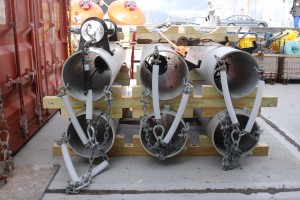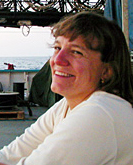This morning the OSNAP float group got some good news. Before I reveal the good news, I need to explain how floats are being used in OSNAP. Freely drifting, neutrally buoyant floats will be released from the ship and sink down to near the sea floor. There they will drift with the deepest currents in the North Atlantic for two years. They are called RAFOS floats, which is the backwards spelling of the word SOFAR, which stands for Sound Fixing and Ranging. Sound underlies how the floats are tracked. While underwater, they will listen for signals from 10 “sound sources” (see photo of sound source tubes on the deck of the Knorr) that we are anchoring to the sea floor throughout this area. Sound can travel for 1000s of kilometers in the ocean—that is one reason whales can communicate with each other over long distances. Knowing the time of arrival of the sound signals from at least two sound sources, and the speed of sound in water, we can determine the float’s position every day. Well, this is all done after the fact, since the float just stores the times it hears the sound sources in its mini-computer inside, and only sends the data to us via satellite after it comes back to the sea surface in two years. Then we reconstruct the “trajectory” or path of the float for the past two years. During the OSNAP project, we will be deploying 120 floats and they will be listening to 10 sources throughout the northern North Atlantic. So the sound sources are critical to our measurement of the deep currents in the ocean.


 Amy Bower is a physical oceanographer at the Woods Hole Oceanographic Institution. She has been chasing ocean currents in the Atlantic and Indian Oceans for over 25 years, primarily by releasing acoustically tracked floats far below the sea surface. Legally blind since her mid-20s, Amy uses adaptive technology to continue her research.
Amy Bower is a physical oceanographer at the Woods Hole Oceanographic Institution. She has been chasing ocean currents in the Atlantic and Indian Oceans for over 25 years, primarily by releasing acoustically tracked floats far below the sea surface. Legally blind since her mid-20s, Amy uses adaptive technology to continue her research.